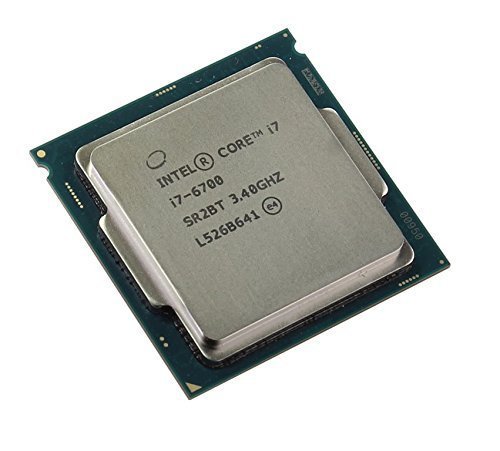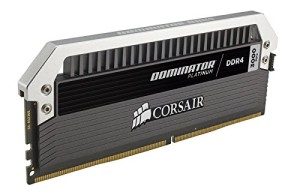
Whether you are after a custom PC for playing the latest from Call of Duty, Battlefields, Total War or you are just plain tired of the offerings of pre-built PCs from your local store. Maybe you need a faster custom pc for video or photo editing. Building your own custom computer is the way to go.
Building your own PC can be very rewarding. You get to build exactly what you want at the price you want. Even better is that you will learn more about computers in a few hours than you ever did before!
Below is a list of all the parts needed to build a PC. Further below is also a list of some optional components.
Also, on the next page you can see a list of recommended parts on the type of PC you want, if its a base computer, a middle-of-the-road or a high performance gaming machine, you can click: Choosing your parts and operating system to go there now.
Here Are All the Parts You’ll Need to Build Your First Custom PC
- Processor (CPU)
- Motherboard
- Power Supply Unit (PSU)
- Case
- Memory (RAM)
- Video Card (Graphics Card
- Storage Drive (HD/SSD)
The details of each component are listed further below. But first and foremost you’ll need tools.
Tools
Starting off with the right tools will save frustration and time later. I promise.
Rosewill offers a great 45-piece kit with all the tools needed to build and maintain your computer. Each tool is demagnetised to ensure your hard drive will not accidentally become damaged.
This 80-piece kit includes everything from XOOL and flat head screwdrivers to tweezers for collected those lost, dropped screws as well as a easy to handle carrying case.

XOOL 80 in 1 Precision Set with Magnetic Driver Kit, Professional Electronics Repair Tool Kit with Portable Oxford Bag for Repair Cell Phone, iPhone, iPad, Watch, Tablet, PC, MacBook
If this kit doesn’t interest you, you can find a few other tools below to get you started on your computer build.
Computer Components List
Every PC is made of the same basic hardware. Each item listed below has a brief explanation, of what the component is and what it does for you.
Processor

The Processor or CPU is the “brain” of your computer, it performs the tasks requested by the operating system and the software. The faster the processor, the faster it performs the tasks.
One thing to note though is that most people will not use the full speed of a high performance CPU, even if your a hardcore gamer the GPU (graphics card) is the far more important component to get the performance you want.
Unless you are after the a cheaper & less powerful CPU will probably be fine, so don’t waste your cash. Get the CPU for the tasks you need today and always remember that as you building your own, you can always upgrade components later.
Motherboard

The motherboard is the base of you’re entire PC. It connects all the components together. It has all the core items needed to run the computer such as the expansion slots (PCI, PCIe), connectors for the monitor, speakers, network and USB ports.
They do come in different sizes or “form factors”, so it determines the size of you computer/computer case. The mid-range size is typically the best option. Most people who opt for the larger towers are for expansion bays to house additional hard drives & DVD drives.
Many modern motherboards have onboard video and sound. If you want higher performing video and sound keep in mind how many and type of expansion slots you need.
If you know you definitly want your own video card then opt for a mainboard without on board video.
Case

The case holds all of your parts together and inside a neat box. Generally its features are less about performance and more about the location in your home or office. That is where does it need to fit and most importantly its dust protection and noise.
What generates the most noise are the fans which keep the computer cool and to a lesser extent the hard drives. Noise is an important factor. A noisy computer humming away can slowly drive you crazy! Select a computer case which highlights “quiet” as a feature.
Additionally if you are adding extra fans ensure that they have noise dampening as a feature. Also consider buying SSD hard drives over traditional SATA as they perform faster and without noise.
Memory
 RAM or more commonly known as “Memory” stands for Random Access Memory. It’s kind of like your short term memory. It stores temporary information your computer needs to make programs run faster and stores data such as open documents etc whilst you have them open.
RAM or more commonly known as “Memory” stands for Random Access Memory. It’s kind of like your short term memory. It stores temporary information your computer needs to make programs run faster and stores data such as open documents etc whilst you have them open.
If you need to run alot of programs at once or have high storage needs for large data files (documents, spreadsheets, presentations etc) then the more memory you have the faster everything runs.
The size of RAM required is a moving target, however it is the cheapest and fastest way to upgrade your computer if you find it running slowly. This is a sliding scale however there will come a point where more memory will not necessarily mean better performance.
If you run virtual machines for developing, testing or just playing with other operating systems such as linux then you will need more RAM to accommodate this.
As a rule of thumb requirement 8GB of RAM is required to run Windows 10 along with your normal applications, remember this is a moving target and your mileage may differ.
Graphics Card
 The Graphics card, also known as a video card but more accurately the GPU is a processor which is specifically made to handle graphics. This is what you plug your screen into and draws all the information you see on the monitor.
The Graphics card, also known as a video card but more accurately the GPU is a processor which is specifically made to handle graphics. This is what you plug your screen into and draws all the information you see on the monitor.
For those purposes you will definitely need a dedicated graphics card. The prices and needs of graphics cards differ greatly but don’t spend more than for what you need right now as fast as they may be it will be outdated within months.
Storage

Example of a Solid State Drive (SSD)

Example of a physical SATA Hard Drive
Hard drives come in many different sizes and speeds. The type of hard drive will be determined by how much data you have to store and speed.
Hard drive speed can be a factor, this is by no means a be-all and end-all but there are basically two types. SATA which has physical platters to store the data and spin around with a needle which reads and writes the information, then there is SSD (solid state drive) these produce no noise and are significantly faster.
Optical Drive

The optical drive or known more widely as a CD, or DVD/Bluray drive. With so much available for download and the use of USB sticks/drives not everyone needs an optical drive these days. However one is recommended if you are building a HTPC (Home Theater PC).
As these are typically quite cheap, about $20 depending then its not an expensive addition to your computer. You may also which to burn DVDs or Blu-Rays for data/movies or permanent backups for example, these are more expensive though.
Power Supply
 The power supply unit (PSU), is possibly the least exciting but most important part of your computer. It directs electricity to the components in your PC.
The power supply unit (PSU), is possibly the least exciting but most important part of your computer. It directs electricity to the components in your PC.
The considerations here are the demands and number of components in your machine – the higher performing graphics cards, number and type of hard drives and the CPU the higher wattage power supply is required. The power supply should be the last component you shop for once you’ve chosen all the other parts.
Parts list for building an Entry Level Gaming PC
Below is a list for recommended parts for an entry level gaming PC. All prices are up to date as of July 5th 2018. Note that all prices are in $USD, however if you are in the UK or Canada, the links will take you to your local Amazon store.
Wallet friendly PC build for under $600
- Motherboard – Gigabyte B365M DS3H (LGA1151/Intel/Micro ATX/USB 3.1 Gen 1 (USB3.0) Type A/DDR4
- CPU – Intel Pentium G Series 3.50 GHz Dual-Core LGA 1151 Processor
- Memory – Corsair Vengeance LPX 8GB (2x4GB) DDR4 DRAM 2400MHz (PC4 19200) C16 Memory Kit
- Storage – (SATA) Toshiba 2TB Desktop 7200rpm Internal Hard Drive And/Or SSD (Highly recommended for your Operating System drive) SanDisk SSD PLUS 240GB Internal SSD – SATA III 6 Gb/s, 2.5″/7mm, Up to 530 MB/s – SDSSDA-240G-G26
- Video Card – MSI Gaming GeForce GT 710 2GB GDRR3 64-bit HDCP Support DirectX 12 OpenGL 4.5 Heat Sink Low Profile Graphics Card
- Case – Thermaltake Versa H22 Black ATX Mid Tower Perforated Metal Front and Top Panel Gaming Computer Case 2.0 Edition with One 120mm Rear Fan Pre-Installed
- Power Supply – Seasonic S12III 500 SSR-500GB3 500W 80+ Bronze ATX12V & EPS12V Direct Cable Wire Output Smart & Silent Fan Control 5 Year Warranty
Optional Computer Parts and Accessories
- <DVD/Bluray Internal (writer) LG Electronics 14x SATA Blu-ray Internal Rewriter without Software, Black (WH14NS40) Or External / USB – Black External Blu-ray Movies DVD Players, Slot Loading Portable USB Optical Drive for Asus Acer Notebook PC Gaming Laptop Windows 8 10 Mac OS Computer Desktop, Super Multi 8X DVD+-R/RW 24X CD Writer
- Keyboard & Mouse – AmazonBasics USB Wired Computer Keyboard and Wired Mouse Bundle Pack
- Monitor – Sceptre E205W-16003R 20″ 75Hz Ultra Thin Frameless LED Monitor 2x HDMI VGA Built-in Speakers, Metallic Black 2018
- Speakers – Logitech S120 2.0 Stereo Speakers
- Sound Card (Note – with any modern motherboard typically have on-board sound) – Optimal Shop PCIe Sound Card for PC Windows 10,5.1 Internal Sound Card with Low Profile Bracket, 3D Stereo PCI-e Audio Card,CMI8738 Chip 32/64 Bit for Windows XP / 7/8
- Modem (Do you really need this?!) (Used for a dial up internet connection if you are not going with Cable or DSL) USB 56K External Dial Up Voice Fax Data Modem Windows 10/8/7/XP/Vista
- Power Strip – Tripp Lite 6 Outlet Surge Protector Power Strip 6ft Cord
- Inkjet Printer – Brother Wireless All-in-One Inkjet Printer, MFC-J491DW, Multi-Function Color Printer, Duplex Printing, Mobile Printing,Amazon Dash Replenishment Enabled
- Scanner – Epson Workforce ES-50 Portable Sheet-fed Document Scanner for PC (You’re much better off getting a printer with scanning function!) such as the HP OfficeJet 3830 All-in-One Wireless Printer
Selecting the perfect case for your computer
The award winning Thermaltake Versa N24 Black ATX Mid Tower Gaming Computer Case Chassis” is engineered for the extreme gamer or graphic designer. It comes a 120x120x25 mm fan and a pre-installed 120mm intake fan with an integrated dust filter optimize system ventilation.
The Thermaltake gaming case surpasses all our expectations with plenty of room for hardware and upgrades. It is recommended you use the Thermaltake TOUGHPOWER 750w Power Supply with this case.
Click here to buy the Thermaltake Versa N21 ATX Mid Tower Case on Amazon
Here are a few other recommended cases to get you started on building your own computer:
All prices below are correct as at 10 Jan 2020.
- Thermaltake V3 Tower (Black) $51.27
-
Cooler Master MasterBox E300L mATX Tower

It was a good one for building a PC. if the Support team could add some more parts it would be better.